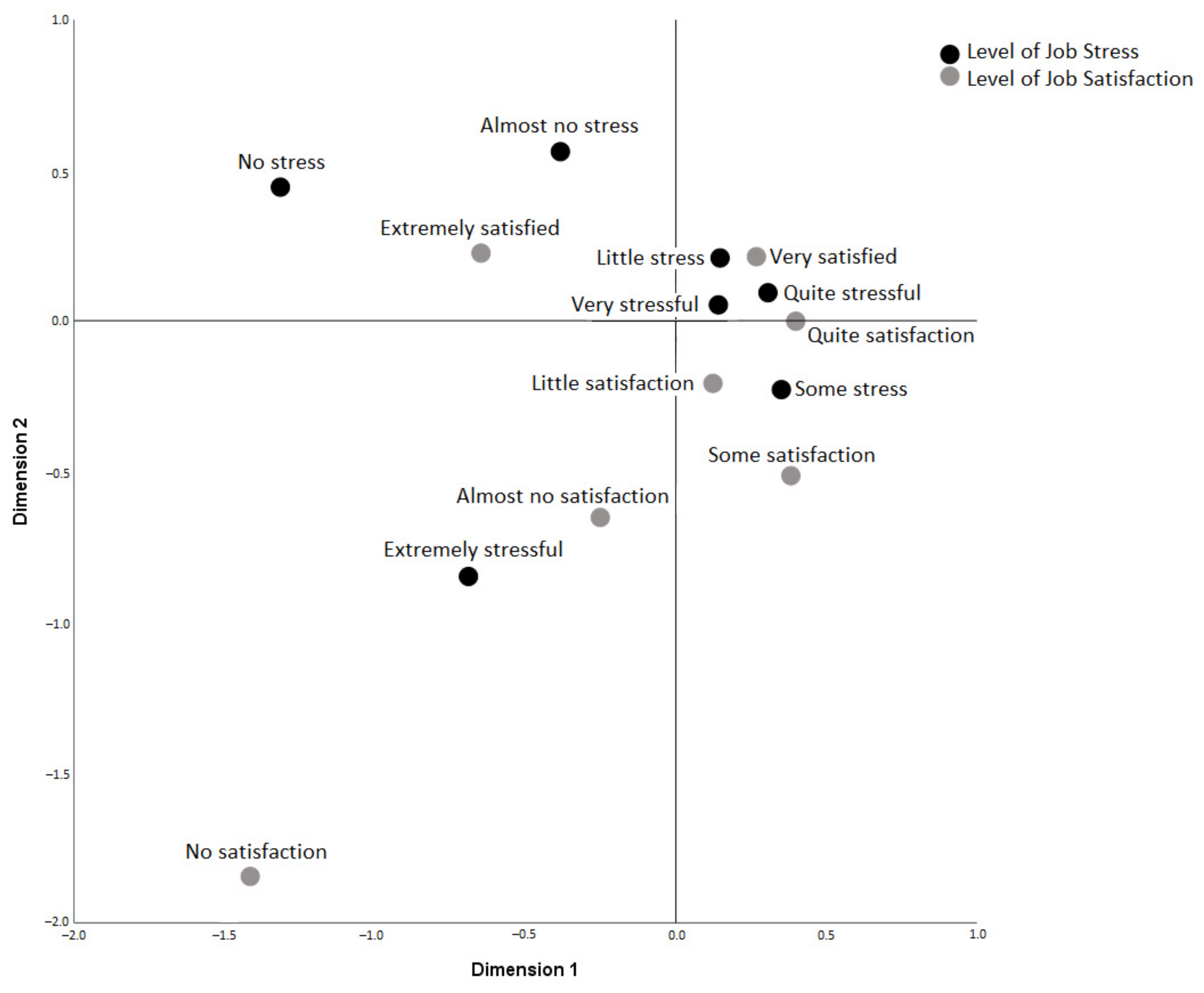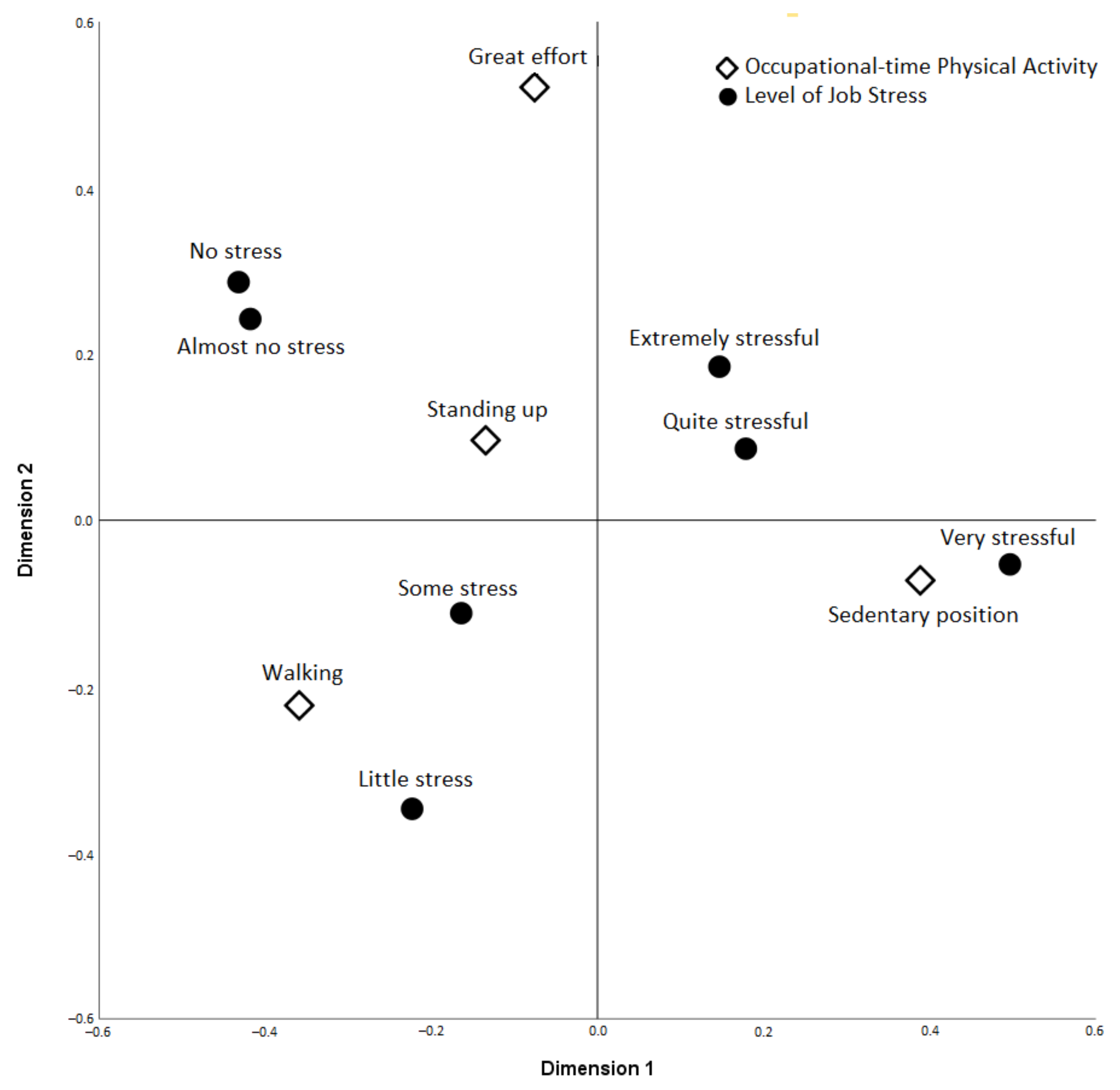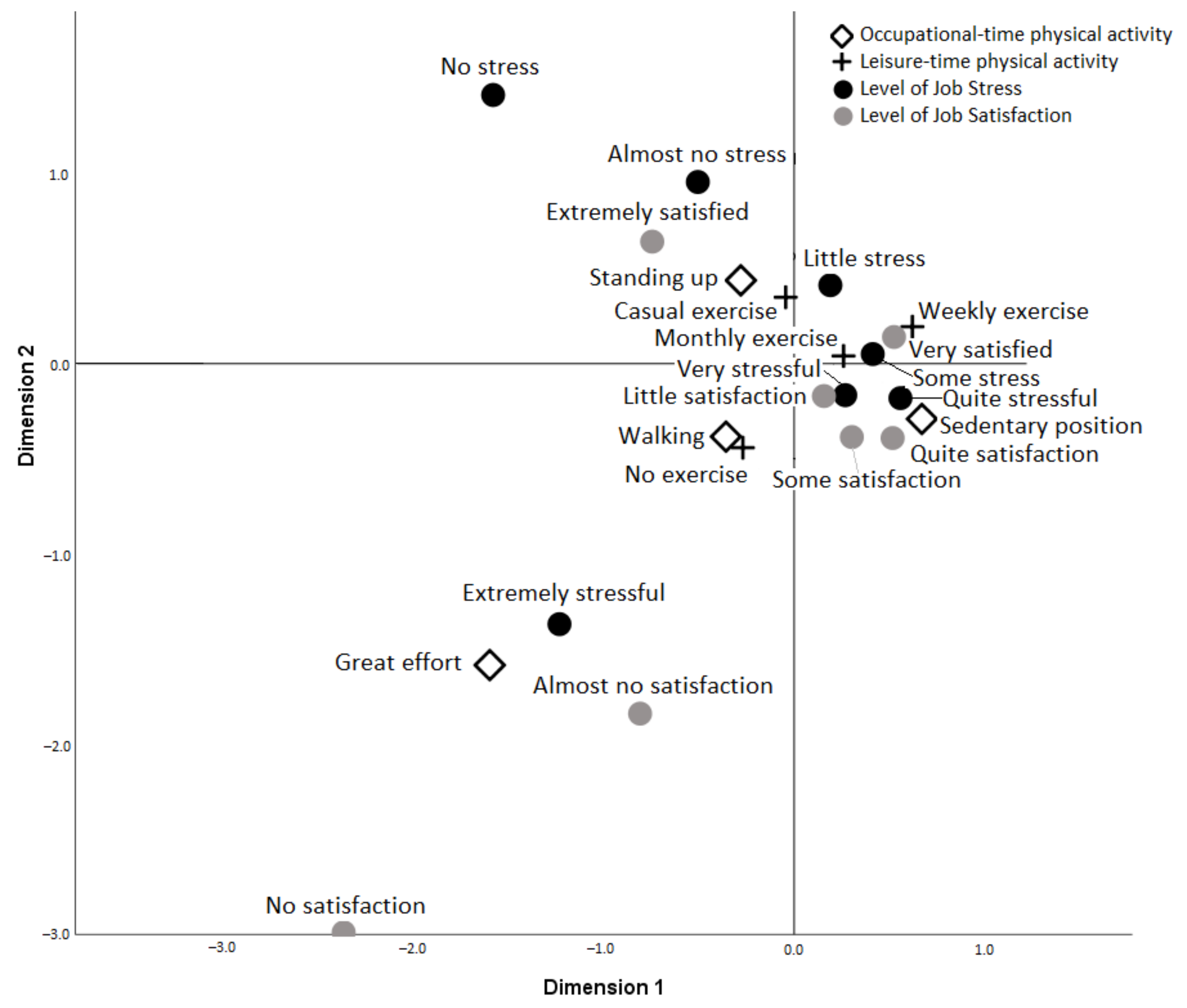Occupational and Leisure-Time Physical Activity Related to Job Stress and Job Satisfaction: Correspondence Analysis on a Population-Based Study
Abstract
1. Introduction
2. Materials and Methods
2.1. Study Design Population and Sample
2.2. Variables and Measurements
2.3. Ethical and Legal Aspects
2.4. Statistic Analysis
3. Results
3.1. Characteristics of the Study Sample
3.2. Univariate Inferential Analysis
3.3. Multiple Correspondence Analysis
4. Discussion
5. Conclusions
Author Contributions
Funding
Institutional Review Board Statement
Informed Consent Statement
Data Availability Statement
Conflicts of Interest
References
- Lera-López, F.; Ollo-López, A.; Sánchez-Santos, J.M. How Does Physical Activity Make You Feel Better? The Mediational Role of Perceived Health. Appl. Res. Qual. Life 2016, 12, 511–531. [Google Scholar] [CrossRef]
- Harari, G.; Green, M.S.; Zelber-Sagi, S. Combined association of occupational and leisure-time physical activity with all-cause and coronary heart disease mortality among a cohort of men followed-up for 22 years. Occup. Environ. Med. 2015, 72, 617–624. [Google Scholar] [CrossRef] [PubMed]
- Holtermann, A.; Krause, N.; Van Der Beek, A.J.; Straker, L. The physical activity paradox: Six reasons why occupational physical activity (OPA) does not confer the cardiovascular health benefits that leisure time physical activity does. Br. J. Sports Med. 2017, 52, 149–150. [Google Scholar] [CrossRef]
- The Lancet Public Health. Time to tackle the physical activity gender gap. Lancet Public Health 2019, 4, e360. [Google Scholar] [CrossRef]
- Da Rocha Morgado, F.F.; de Souza do Vale, W.; Lopes, C.S.; de Albuquerque Maranhão Neto, G.; Lattari, E.; Mediano, M.F.F.; Rostila, M.; Griep, R.H.; Machado, S.; Penna, T.A.; et al. Psychosocial determinants of physical activity among workers: An integrative review. Rev. Bras. Med. Trab. 2020, 18, 472–487. [Google Scholar] [CrossRef] [PubMed]
- Holtermann, A.; Hansen, J.V.; Burr, H.; Søgaard, K.; Sjøgaard, G. The health paradox of occupational and leisure-time physical activity. Br. J. Sports Med. 2011, 46, 291–295. [Google Scholar] [CrossRef] [PubMed]
- Kerner, I.; Rakovac, M.; Lazinica, B. Leisure-time physical activity and absenteeism. Arch. Ind. Hyg. Toxicol. 2017, 68, 159–170. [Google Scholar] [CrossRef]
- Sánchez-Sellero, M.C.; Sánchez-Sellero, P.; Cruz-González, M.M.; Sánchez-Sellero, F.J. Organizational characteristics in the labour satisfaction in Spain. Rev. Adm. Empres. 2014, 54, 537–547. [Google Scholar] [CrossRef]
- Andersen, L.L.; Fishwick, D.; Robinson, E.; Wiezer, N.M.; Mockałło, Z.; Grosjean, V. Job satisfaction is more than a fruit basket, health checks and free exercise: Cross-sectional study among 10,000 wage earners. Scand. J. Public Health 2017, 45, 476–484. [Google Scholar] [CrossRef]
- Organización Internacional del Trabajo. Estrés en el Trabajo. Un Reto Colectivo. [Stress at Work. A Collective Challenge]; Organización Internacional del Trabajo: Ginebra, Suiza, 2016; Available online: https://www.ilo.org/wcmsp5/groups/public/---ed_protect/---protrav/---safework/documents/publication/wcms_466549.pdf(In Spanish). (accessed on 3 March 2021). (In Spanish)
- Stults-Kolehmainen, M.A.; Sinha, R. The effects of stress on physical activity and exercise. Sport Med. 2014, 44, 81–121. [Google Scholar] [CrossRef]
- Häusser, J.; Mojzisch, A. The physical activity-mediated Demand-Control (pamDC) model: Linking work characteristics, leisure time physical activity, and well-being. Work Stress 2017, 31, 209–232. [Google Scholar] [CrossRef]
- Fransson, E.I.; Heikkilä, K.; Nyberg, S.T.; Zins, M.; Westerlund, H.; Westerholm, P.; Väänänen, A.; Virtanen, M.; Vahtera, J.; Theorell, T.; et al. Job strain as a risk factor for leisure-time physical inactivity: An individual-participant meta-analysis of up to 170,000 men and women. Am. J. Epidemiol. 2012, 176, 1078–1089. [Google Scholar] [CrossRef]
- Buss, J. Associations between Obesity and Stress and Shift Work among Nurses. Workplace Health Saf. 2012, 60, 453–458. [Google Scholar] [CrossRef]
- Nyberg, S.T.; Heikkilä, K.; Fransson, E.; Alfredsson, L.; De Bacquer, D.; Bjorner, J.B.; Bonenfant, S.; Borritz, M.; Burr, H.; Casini, A.; et al. Job strain in relation to body mass index: Pooled analysis of 160000 adults from 13 cohort studies. J. Intern. Med. 2012, 272, 65–73. [Google Scholar] [CrossRef] [PubMed]
- Pujol-Cols, L.J.; Dabos, G.E. Satisfacción laboral: Una revisión de la literatura acerca de sus principales determinantes. Estud. Gerenciales 2018, 34, 3–18. [Google Scholar] [CrossRef]
- Gell, N.M.; Wadsworth, D.D. How Do They Do It: Working Women Meeting Physical Activity Recommendations. Am. J. Heal. Behav. 2014, 38, 208–217. [Google Scholar] [CrossRef][Green Version]
- Boniol, M.; McIsaac, M.; Xu, L.; Wuliji, T.; Diallo, K.; Campbell, J. WHO|Gender Equity in the Health Workforce: Analysis of 104 Countries [Internet]; World Health Organization: Geneva, Switzerland, 2019; Available online: https://apps.who.int/iris/handle/10665/311314 (accessed on 3 March 2021).
- Ministerio de Sanidad Servicios Sociales e Igualdad. Encuesta Nacional de Salud. España 2017 (ENSE 2017) [Spanish National Health Survey] [Internet]. Vol. 6. 2017. Spanish. Available online: https://www.mscbs.gob.es/estadEstudios/estadisticas/encuestaNacional/encuesta2017.htm (accessed on 14 January 2021).
- Pérez_Soto, J.; García_Cantó, E. Medición de la actividad física mediante el International Physical Activity Questionnaire (IPAQ) en estudios españoles e internacionales [Physical Activity measurement through the International Physical Activity Questionnaire (Ipaq) in Spanish and International studies]. Act. Física Cienc. 2012, 4, 1–21. (In Spanish) [Google Scholar]
- Mantilla Toloza, S.; Gómez-Conesa, A. El cuestionario internacional de actividad física. Un instrument adecuado en el seguimiento de la actividad física poblacional [International Physical Activity Questionnaire. An adequate instrument in population physical activity monitoring]. Rev. Iberoam. Fisioter. Kinesiol. 2007, 10, 48–52. (In Spanish) [Google Scholar] [CrossRef]
- Estefanía Osorio, J.; Cárdenas Niño, L. Estrés laboral: Estudio de revisión [Work stress: A review study]. Divers. Perspect. Psicol. 2017, 13, 81–90. (In Spanish) [Google Scholar] [CrossRef]
- Vidal Lacosta, V. El Estrés Laboral. Análisis y Prevención [Occupational Stress: Analysis and Prevention], 1st ed.; Prensas de la Universidad de Zaragoza: Zaragoza, Spain, 2019; p. 19. (In Spanish) [Google Scholar]
- Sánchez Cañizares, S.M.; Fuentes García, F.J.; Artacho Ruiz, C. La satisfacción laboral desde la perspectiva de género: Un análisis empírico mediante modelos logit y probit [Job satisfaction from a gender perspective: An empirical analysis using logit and probit models]. Conoc. Innov. Emprend. Camino Futur. 2007, 7, 3445–3457. (In Spanish) [Google Scholar]
- Hauret, L.; Williams, D.R. Cross-National Analysis of Gender Differences in Job Satisfaction. Ind. Relat. 2017, 56, 203–235. [Google Scholar] [CrossRef]
- Fernandez Puente, A.; Sanchez-Sanchez, N. Once in the Public Sector, Do Differences in Job Satisfaction by Gender Disappear? Hacienda Publica Esp. 2020, 234, 75–104. [Google Scholar] [CrossRef]
- Sánchez-Sánchez, N.; Fernández Puente, A.C. Is women’s job satisfaction higher than men´s? Self-selection, expectations or utility function. Acta Oeconomica 2019, 69, 161–189. [Google Scholar] [CrossRef]
- OSALAN-Instituto Vasco de Seguridad y Salud. Principales Factores de Género que Inciden en las Actitudes y Comportamientos ante los Riesgos Laborales y en los daños Derivados de los Mismos [Main Gender Factors Affecting Attitudes and Behaviors in Relation to Occupational Hazards and Related Damages], 1st ed.; Instituto Vasco de Seguridad y Salud: Barakaldo, Spain, 2021; pp. 1–142. (In Spanish) [Google Scholar]
- Dėdelė, A.; Miškinytė, A.; Andrušaitytė, S.; Bartkutė, Ž. Perceived stress among different occupational groups and the interaction with sedentary behaviour. Int. J. Environ. Res. Public Health 2019, 16, 4595. [Google Scholar] [CrossRef] [PubMed]
- Cillekens, B.; Lang, M.; Van Mechelen, W.; Verhagen, E.; Huysmans, M.A.; Holtermann, A.; Van Der Beek, A.J.; Coenen, P. How does occupational physical activity influence health? An umbrella review of 23 health outcomes across 158 observational studies. Br. J. Sports Med. 2020, 54, 1474–1481. [Google Scholar] [CrossRef] [PubMed]
- Ferrario, M.M.; Roncaioli, M.; Veronesi, G.; Holtermann, A.; Clays, E.; Borchini, R.; Cavicchiolo, M.; Grassi, G.; Cesana, G. Differing associations for sport versus occupational physical activity and cardiovascular risk. Heart 2018, 104, 1165–1172. [Google Scholar] [CrossRef]
- Navinés, R.; Martín-Santos, R.; Olivé, V.; Valdés, M. Estrés laboral: Implicaciones para la salud física y mental [Work-related stress: Implications for physical and mental health]. Med. Clin. 2016, 146, 359–366. [Google Scholar] [CrossRef]
- Azofeifa Mora, C. Revisión de los beneficios de la intensidad y modalidades del ejercicio físico sobre el estrés psicológico [Review of the benefits of physical exercise intensity and modalities on psychological stress]. Pensar Mov. Rev. Cienc. Ejerc. Salud 2018, 16, 1–21. (In Spanish) [Google Scholar]
- Stalsberg, R.; Pedersen, A.V. Are differences in physical activity across socioeconomic groups associated with choice of physical activity variables to report? Int. J. Environ. Res. Public Health 2018, 15, 922. [Google Scholar] [CrossRef]
- Instituto Nacional de Seguridad y Salud en el Trabajo (INSST). Condiciones de Trabajo Según Género en España 2015 [Working Conditions by Gender in Spain 2015] [Internet]. 2018. Available online: https://www.insst.es/documentacion/catalogo-de-publicaciones/condiciones-de-trabajo-segun-genero-en-espana-2015-ano-2018 (accessed on 19 March 2021). (In Spanish).



| Men (n = 4621) | Women (n = 4095) | p Value | ||
|---|---|---|---|---|
| Age | 44.83 (SD = 10.22) | 44.55 (SD = 10.23) | 0.431 | |
| Job stress level | No stress | 295 (6.4%) | 281 (6.9%) | 0.001 |
| Almost no stress | 420 (9.1%) | 323 (7.9%) | ||
| Little stress | 630 (13.6%) | 506 (12.4%) | ||
| Some stress | 999 (21.6%) | 807 (19.7%) | ||
| Quite stressful | 1171 (25.3%) | 1078 (26.3%) | ||
| Very stressful | 675 (14.6%) | 621 (15.2%) | ||
| Extremely stressful | 431 (9.3%) | 479 (11.7%) | ||
| Job satisfaction level | No satisfaction | 81 (1.8%) | 79 (1.9%) | 0.003 |
| Almost no satisfaction | 97 (2.1%) | 97 (2.4%) | ||
| Little satisfaction | 245 (5.3%) | 185 (4.5%) | ||
| Some satisfaction | 595 (12.9%) | 495 (12.1%) | ||
| Quite satisfaction | 1071 (23.2%) | 849 (20.7%) | ||
| Very satisfied | 1312 (28.4%) | 1125 (27.5%) | ||
| Extremely satisfied | 1220 (26.4%) | 1265 (30.9%) | ||
| Occupation | Managing director of companies with 10 or more employees and professionals associated with university degrees | 629 (13.6%) | 665 (16.2%) | <0.001 |
| Managing director of companies with less than 10 employees and professionals associated with university diploma. Athletes and artists. | 448 (9.7%) | 469 (11.5%) | ||
| Intermediate occupations and self-employed workers | 985 (21.3%) | 975 (23.8%) | ||
| Supervisors and workers in qualified technical occupations | 755 (16.3%) | 395 (9.6%) | ||
| Skilled workers in the primary sector and other semi-skilled workers | 1393 (30.1%) | 1131 (27.6%) | ||
| Unskilled workers | 411 (8.9%) | 460 (11.2%) | ||
| Education level | He does not know to read nor to write | 2 (0.04%) | 4 (0.1%) | <0.001 |
| Incomplete Primary Education (<5 years in school) | 78 (1.7%) | 36 (0.9%) | ||
| Complete Primary Education. | 384 (8.3%) | 246 (6.0%) | ||
| Elementary Bachelor | 1328 (28.7%) | 816 (19.9%) | ||
| Bachelor | 606 (13.1%) | 522 (12.7%) | ||
| Professional education of intermediate degree or equivalent | 435 (9.4%) | 425 (10.4%) | ||
| Professional education of a higher degree or equivalent | 647 (14.0%) | 503 (12.3%) | ||
| University studies or equivalent | 1141 (24.7%) | 1543 (37.7%) | ||
| Occupational-time physical activity | Sitting most of the day | 1579 (34.2%) | 1430 (34.9%) | <0.001 |
| Standing for most of the day without making great movements or efforts | 1719 (37.2%) | 1935 (47.3%) | ||
| Walking. Carrying some weight. | 995 (21.5%) | 604 (14.7%) | ||
| Performing tasks that require great physical effort | 328 (7.1%) | 126 (3.1%) | ||
| Leisure-time physical activity | None | 1467 (31.7%) | 1490 (36.4%) | <0.001 |
| Occasionally | 1434 (31.0%) | 1531 (37.4%) | ||
| Sometimes in the month | 898 (19.4%) | 548 (13.4%) | ||
| Several times in a week | 822 (17.8%) | 526 (12.8%) |
| Men (n = 4621) | Women (n = 4095) | ||||
|---|---|---|---|---|---|
| Indicator | p | Indicator | p | ||
| Job stress | Job satisfaction | Ʈb = −0.076 | <0.001 | Ʈb = −0.084 | <0.001 |
| Occupation | d = −0.1 | <0.001 | D = −0.047 | <0.001 | |
| Education level | d = 0.068 | <0.001 | d = 0.055 | <0.001 | |
| Occupational-time Physical Activity | d = −0.063 | <0.001 | d = −0.017 | 0.24 | |
| Leisure-time Physical Activity | Ʈb = −0.005 | 0.666 | Ʈb = −0.029 | 0.024 | |
| Job satisfaction | Occupation | D = −0.047 | <0.001 | D = −0.075 | <0.001 |
| Education level | d = −0.025 | 0.031 | d = 0.055 | <0.001 | |
| Occupational-time Physical Activity | d = 0.019 | 0.136 | d = 0.037 | 0.013 | |
| Leisure-time Physical Activity | Ʈb = 0.005 | 0.681 | Ʈb = 0.043 | 0.001 | |
Publisher’s Note: MDPI stays neutral with regard to jurisdictional claims in published maps and institutional affiliations. |
© 2021 by the authors. Licensee MDPI, Basel, Switzerland. This article is an open access article distributed under the terms and conditions of the Creative Commons Attribution (CC BY) license (https://creativecommons.org/licenses/by/4.0/).
Share and Cite
de-Pedro-Jiménez, D.; Meneses-Monroy, A.; de Diego-Cordero, R.; Hernández-Martín, M.M.; Moreno-Pimentel, A.G.; Romero-Saldaña, M. Occupational and Leisure-Time Physical Activity Related to Job Stress and Job Satisfaction: Correspondence Analysis on a Population-Based Study. Int. J. Environ. Res. Public Health 2021, 18, 11220. https://doi.org/10.3390/ijerph182111220
de-Pedro-Jiménez D, Meneses-Monroy A, de Diego-Cordero R, Hernández-Martín MM, Moreno-Pimentel AG, Romero-Saldaña M. Occupational and Leisure-Time Physical Activity Related to Job Stress and Job Satisfaction: Correspondence Analysis on a Population-Based Study. International Journal of Environmental Research and Public Health. 2021; 18(21):11220. https://doi.org/10.3390/ijerph182111220
Chicago/Turabian Stylede-Pedro-Jiménez, Domingo, Alfonso Meneses-Monroy, Rocío de Diego-Cordero, Marta María Hernández-Martín, Antonio Gabriel Moreno-Pimentel, and Manuel Romero-Saldaña. 2021. "Occupational and Leisure-Time Physical Activity Related to Job Stress and Job Satisfaction: Correspondence Analysis on a Population-Based Study" International Journal of Environmental Research and Public Health 18, no. 21: 11220. https://doi.org/10.3390/ijerph182111220
APA Stylede-Pedro-Jiménez, D., Meneses-Monroy, A., de Diego-Cordero, R., Hernández-Martín, M. M., Moreno-Pimentel, A. G., & Romero-Saldaña, M. (2021). Occupational and Leisure-Time Physical Activity Related to Job Stress and Job Satisfaction: Correspondence Analysis on a Population-Based Study. International Journal of Environmental Research and Public Health, 18(21), 11220. https://doi.org/10.3390/ijerph182111220








